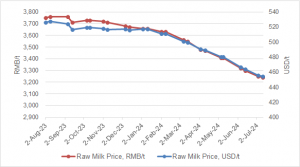
Milk NZ general manager Roy van den Hurk says this health push and covid-related shipping issues experienced by European competitors meant the product is currently a “darling” of NZ dairy exports.
“UHT milk has done very well, it has maintained its level and it’s still growing,” Van den Hurk said in an NZX-webinar.
Domestic producers were constructing factories to add value to their milk, but he says this milk will be going into other products other than UHT milk.
“Combined with the fact that the Chinese are going to consume more dairy, the domestic players are going to be adding value into other products, that means there will be an opportunity for more liquid milk to go into China,” he said.
“I have a fundamental belief that the growth and the uptake of dairy products in China is going to increase and I would say in an educated guess, it could double in the next 10-15 years.”
This presented a huge opportunity because he did not believe Chinese domestic raw milk production levels were going to change much in the next 10-15 years.
“The most important thing for me is China’s Five-Year Plan. If they’re putting emphasis on dairy, and they have been lately, and the Government’s endorsing high-protein dairy, I think that’s a big positive because that really will drive the sales,” he said.
On a per capita basis, Chinese people consumed very little dairy and there was a lot of opportunity for China to grow this.
“That’s definitely happening as their economy grows,” he said.
Milk NZ has been exporting UHT milk to China since 2014, mainly for the retail market.
The bulk of domestic milk production in China is in UHT milk and while the country still imported large quantities of dairy, he says only a small proportion of that product was UHT – around 2.5%.
Of that small percentage, around 35% came from Germany and 30% came from NZ.
The rest came from Australia, France, Poland and other countries. Those percentages from the European countries tended to change depending on whether the EU had a milk surplus.
The domestic market is dominated by Yili, Mengniu and Bright Dairy, with imported milk taking up a small percentage.
NZ UHT milk sales operated in that small percentage. The product is seen and sold as a premium product in China and was priced well above its other imported competitors.
“The Chinese consumers do appreciate it and do want that type of quality. They’re all about health and New Zealand is getting a premium for its product,” he said.
Brand and country of origin were very important for Chinese consumers. Milk NZ had to build its brand from scratch and relied heavily on its country of origin to make inroads into the Chinese market.
More UHT product is also being sold by e-commerce and comprise 25-30% of the market in the bigger cities and Milk NZ was focused heavily on these kinds of transactions.
He says the market was moving very quickly and was heavily technology-based.
“The Chinese market is very, very fast in the way it changes and its methodology of getting to the customer and it’s mostly technology based. They are a lot further ahead than New Zealand in this area,” he said.

























